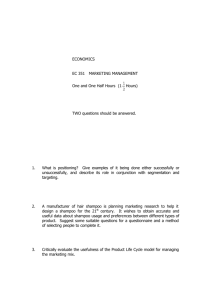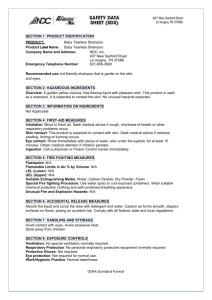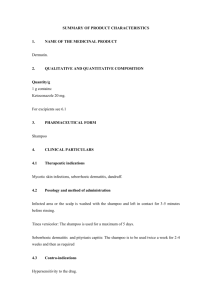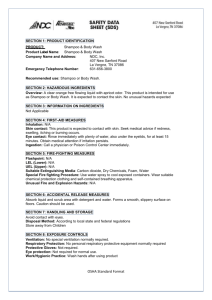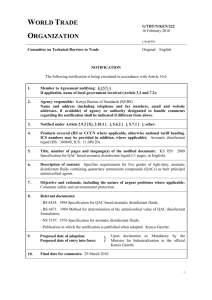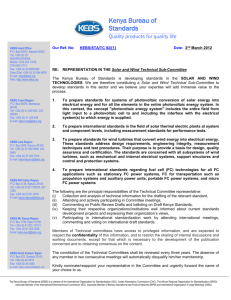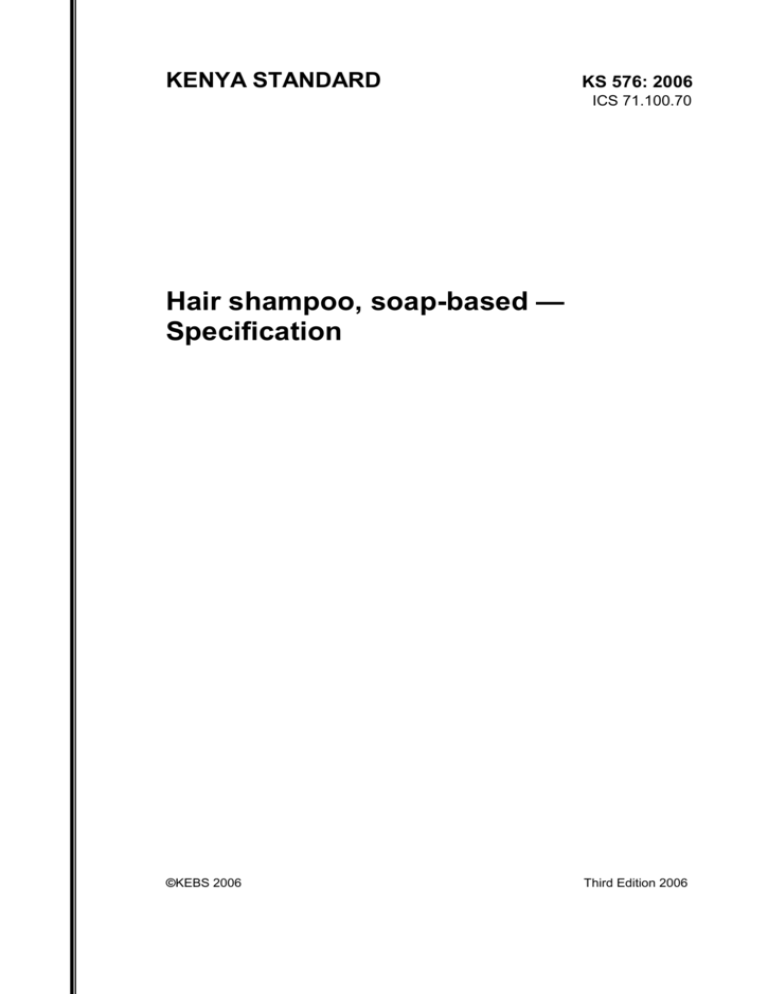
KENYA STANDARD
KS 576: 2006
ICS 71.100.70
Hair shampoo, soap-based —
Specification
©KEBS 2006
Third Edition 2006
KS 576: 2006
TECHNICAL COMMITTEE REPRESENTATION
The following organizations were represented on the Technical Committee:
Haco Industries Ltd.
Beiersdorf (K) Ltd.
Rozeco Chemical Industries
Interconsumer Products
Government Chemist’s Department
Oasis Ltd.
Kenya Industrial Research and Development Institute (KIRDI)
Jomo Kenyatta University of Agriculture and Technology — Chemistry Department
Kenyatta National Hospital — Dermatology Department
National Quality Control Laboratory
Consumer Information Network
Ministry of Health
Kenya Bureau of Standards — Secretariat
REVISION OF KENYA STANDARDS
In order to keep a breast of progress in industry, Kenya Standards shall be regularly reviewed. Suggestions for
improvements to published standards, addressed to the Managing Director, Kenya Bureau of Standards are
welcome.
© Kenya Bureau of Standards, 2006
Copyright. Users are reminded that by virtue of section 6 of the Copyright Act, Cap. 130 of the Laws of Kenya, copyright subsists in all Kenya
Standards and except as provided under section 7 of this Act, no Kenya Standard produced by Kenya Bureau of Standards may be
reproduced, stored in a retrieval system in any form or transmitted by any means without prior permission in writing from the Managing
Director.
Permission may be conditional on an appropriate royalty payment.
Care should be taken to ensure that material used is from the current edition of the standard and that it is updated whenever the standard is
amended or revised. The number and date of the standard should therefore be clearly identified.
The use of material in print or in electronic form to be used commercially with or without payment or in commercial contracts is subject to
payment of a royalty.
ISBN 9966-23-150-1
ii
© KEBS 2006 — All rights reserved
KENYA STANDARD
KS 576: 2006
ICS 71.100.70
Hair shampoo, soap-based —
Specification
KENYA BUREAU OF STANDARDS (KEBS)
Head Office: P.O. Box 54974, Nairobi-00200, Tel.: (+254 020) 605490, 602350, Fax: (+254 020) 604031
E-Mail: info@kebs.org, Web:http://www.kebs.org
Coast Region
P.O. Box 99376, Mombasa-80100
Tel.: (+254 041) 229563, 230939/40
Fax: (+254 041) 229448
© KEBS 2006 — All rights reserved
Lake Region
P.O. Box 2949, Kisumu-40100
Tel.: (+254 057) 23549, 22396
Fax: (+254 057) 21814
Rift Valley Region
P.O. Box 2138, Nakuru-20100
Tel.: (+254 051) 210553, 210555
iii
KS 576: 2006
Foreword
This Third Edition of this Kenya Standard was prepared by the Technical Committee on Cosmetics and Related
Products under the guidance of the Chemical Industry Standards Committee and it is in accordance with the
procedures of the Bureau.
This standard was first issued in 1986. In this First Revision, a new requirement for lather has been included for
consumer satisfaction. A shampoo that develops a dense and luxurious lather gets better consumer acceptance.
Many of the surfactants which are frequently used in shampoos as cleansing agents develop abundant lacy foam
in soft water but this lather drops drastically in the presence of hard water. Therefore, ingredients commonly
known as foam boosters are added to shampoos to improve quality volume and characteristics of lather.
Minimum foam height for a 2 % solution has been specified to quantify this requirement.
In this third edition, new requirements have been included to cater for products containing herbal additives e.g.
Neem extracts.
All materials present in the finished product should be free from any harmful effect. It shall be the responsibility of
the manufacturers of shampoo to satisfy themselves of the dermatological safety of their formulation before
releasing the product for sale.
In the preparation of this Kenya Standard, reference was made to the following documents whose assistance is
highly acknowledged with thanks.
IS 7669: 1990 — Shampoo, Soap based — Specification.
IS 4011: 1982 — Method for dermatological tests for cosmetics.
Acknowledgement is hereby made for the assistance derived from these sources.
iv
© KEBS 2006 — All rights reserved
KENYA STANDARD
KS 576: 2006
Hair shampoo, soap-based — Specification
1
Scope
This standard prescribes the requirements and methods of test for hair shampoo, soap-based.
2
Application
This standard also includes shampoos with positive dermatological effect on the skin and neutralizing
shampoos.
3
Classification
Soap-based shampoos shall be classified into four types:
i)
General purpose shampoo. This shall be for 'Dry', 'Oily' or 'Normal' hair and shall be indicated as so.
ii)
Treatment shampoo.
iii)
Baby Shampoo.
iv)
Neutralizing shampoo.
4
Normative references
The following Kenya Standards are necessary adjuncts to this standard:
KS 03-1707, Labeling of cosmetic products
KS 03-1474, Classification of cosmetic raw materials and adjuncts
KS 03-1668, Methods of sampling cosmetics
The above-mentioned standards contain provisions, which through reference in this text constitute provisions of
this standard.
5
General requirements
5.1
The shampoo shall be in the form of a liquid, emulsion or paste. It may be coloured and perfumed.
5.2
The clear/transparent liquid shampoo, when examined visually, shall be free from any sediment.
5.3
If in the form of an emulsion, the shampoo shall be homogenous and there shall be no visible signs of the
emulsion having broken.
5.4
Shampoo in the form of a paste shall be free from any agglomerated particles.
5.5
The shampoo shall have no undesirable effect on the natural colour of the hair. (This does not include
hair already treated with hair dyes).
5.6
The shampoo shall impart all the effects claimed, e.g. dandruff control.
© KEBS 2006 — All rights reserved
1
KS 576: 2006
6
Ingredients
6.1
All ingredients used, including pigments and colours, shall conform to KS 03-14741).
6.2
Any product containing ingredients for which medicinal claims are made shall be registered with the
Ministry of Health.
6.3
All essential oils/herbs used shall conform to the approved standards where such exist.
6.4
All products containing herbal extracts known to have antibacterial activity e.g. neem oil/extract and aloe
oil/extract shall pass the test for antibacterial activity outlined in Annex F.
6.5
If neem oil is used as part of the formulation, the amount shall be 5-10 % m/m
6.6
A list of ingredients conventionally used in the formulation of shampoos is given for guidance in Annex A.
6.7
All active ingredients including anti-bacterial or anti-dandruff agents, shall be named. Any further
information concerning the active ingredients shall be supplied by the manufacturer on request.
6.8
It shall be the responsibility of the manufacturer to ensure the dermatological safety of their formulations.
For baby shampoos, the active ingredients, perfume and other ingredients shall be of such nature and in such
amounts as to leave the final baby product mild in nature. This is due to the sensitive nature of baby skin.
7
Other requirements
The shampoo shall comply with the requirements given in Table 1.
Table 1 — Requirements for hair shampoo, soap-based
Sl
No
8
Characteristic
i)
Total fatty matter, % by mass, min.
ii)
Matter insoluble in alcohol, % by mass,
max.
iii)
Lather volume for 2 % solution, mL
iv)
Free caustic alkali, as NaOH or KOH, %
by mass, max.
v)
Antibacterial activity, min.
Requirement
Test method
15.0
Annex B
2.0
Annex C
100
Annex D
0.01
Annex E
0.2 mm
Annex F
Packaging
The soap-based hair shampoo shall be packed in suitable containers.
9
Marking
In addition to the labeling requirements outlined in KS 1707, the package shall be legibly and indelibly marked
with the following information in English and/or Kiswahili languages:
i)
1)
2
type of shampoo;
Classification of cosmetic raw materials and adjuncts.
© KEBS 2006 — All rights reserved
KS 576: 2006
ii)
net contents;
iii)
name and address of the manufacturer and registered trade mark, if any;
iv)
batch number or code number;
v)
date of manufacture and 'Best before ...-‘ date;
vi)
country of origin;
vii)
instructions for use;
viii)
all ingredients shall be declared in descending order of predominance. The INCI label names shall be
used.
NOTE INCI stands for International Nomenclature Cosmetic Ingredient.
10
Sampling
Representative samples shall be drawn for test from the market or industry, following the procedure of random
selection. The samples shall be declared as conforming to this standard if they comply with all the specified
requirements.
© KEBS 2006 — All rights reserved
3
KS 576: 2006
Annex A
(normative)
List of ingredients conventionally used in formulation of
soap-based shampoo
A.1
Chelation agents
a)
b)
Sodium polyphosphates
Sodium salt of ethylenediamine tetra-acetic acid (EDTA)
A.2
Preservatives
a)
b)
c)
d)
e)
f)
Alcohols
Formaldehyde
Sorbic acid
Ester of p-hydroxybenzoic acid
Imidazolidinyl urea
Kathon CG (Methylchloroisothiazolinone and methyl-isothiazoline)
A.3
Emollients
a)
Lanoline and its derivatives
A.4
Thickening agents/viscosity enhancers
a)
b)
c)
d)
e)
Sodium carboxymethyl cellulose
Methyl isopropyl cellulose
Methyl cellulose
Methyl glycoside derivatives
Guar gum
A.5
Counter-irritants
a)
b)
c)
Ethoxylated fatty alcohols
Ethoxylated fatty esters
Methyl glycoside derivatives
A.6
Conditioners
a)
b)
c)
Polyquaternary ammonium compounds and monomeric quaternary ammonium compounds
Hydrolized proteins
Amphoterics
A.7
U.V. Stabilizers
a)
Benzophenone derivatives
A.8
Other groups of ingredients
a)
b)
Perfumes
Dyes
4
© KEBS 2006 — All rights reserved
KS 576: 2006
Annex B
(normative)
Determination of total fatty matter
B.1
Outline of the method
The shampoo is split by sulphuric acid and extracted by ethyl ether. The ether is evaporated. The residue is
treated with acetone, evaporated and estimated.
B.2
Reagents
B.2.1
Methyl orange indicator, dissolve 0.1 g in 100 mL of water.
B.2.2
Ethyl ether, analytical reagent grade.
B.2.3
Sodium chloride solution, saturated.
B.2.4
Dilute sulphuric acid, 1:1 (v/v).
B.2.5
Acetone
B.3
Procedure
B3.1
Accurately weigh 5 g of the sample and dissolve in 100 mL of distilled water in a 250 ml conical flask.
when dissolution is complete, add dilute sulphuric acid in slight excess (as judged by methyl orange indicator).
Insert a small funnel into the neck of the flask, and heat the flask to a temperature not exceeding 60C until the
fatty acids separate as a clear layer. Add 50 mL of sodium chloride solution and cool. Transfer quantitatively to
a separating funnel and shake it with three 50 ml portions of ethyl ether. Dissolve the fatty acids in the ether
used for washing the aqueous liquid and extract with 10 ml portions of water until the extracts are no longer acidic
to methyl orange indicator. Mix the water portions used for washing and shake with 20 ml of ether. Wash this
ether until the wash water is neutral to methyl orange indicator.
B.3.2 Distil off the ether slowly on a steam-bath, and add 5 mL of acetone to the residue. In order to minimize
the risk of loss during distillation, the flask should not be more than half full of ether at any stage. Warm the flask
on the stem-bath for about one minute. Remove it from the bath and then, while imparting a rotary motion to the
flask, hold it an angle of 45. Direct a current of dry air into its mouth for one minute, thereby removing the bulk of
acetone. Place the flask in a steam-oven at about 90 C for 10 minutes. Remove it from the oven and blow with
air as before for about 15 seconds. Allow the flask to cool and weigh. Return the flask to the steam-oven for
another 10 minutes and blow for 15 seconds. Allow to cool and reweigh. Repeat the process until the difference
between two consecutive weighings is less than 0.005 g.
B.4
Calculation
Total fatty matter, % by mass =
100 M1
M2
where,
M1 = mass in g of the fatty matter, and
M2 = mass in g of the material taken for the test.
© KEBS 2006 — All rights reserved
5
KS 576: 2006
Annex C
(normative)
Determination of matter insoluble in alcohol
C.1
General
This method may be used for the approximate determination of these constituents. As these salts are not
completely insoluble in alcohol, separate portions of soap should be used for accurate determination, employing
specific methods.
C.2
Method
It consists in digesting the material in alcohol and filtering off the residue, which is dried and weighed.
C.3
Reagents
C.3.1
Phenolphthalein indicator, dissolve 1 g in 100 mL of 95 % rectified spirit.
C.3.2
Ethyl alcohol or rectified spirit, freshly boiled and neutral to phenolphthalein.
C.4
Procedure
C.4.1 Weigh accurately 2 g to 10 g of the sample and digest with 200 mL of freshly boiled ethyl alcohol in a
covered vessel on a steam bath until the soap is dissolved. Filter into a filter flask through a tared, dried and
counterpoised filter paper till neutral to phenolphthalein, or through a tared and dried Gooch or sintered glass
crucible with suction, protecting the solution from carbon dioxide and other acid fumes during the operation by
covering with a watch glass. The filter paper and Gooch crucible shall be prepared as per the method given
under C4.2.
C.4.2 Wash it several times with hot ethyl alcohol to remove all the alcohol solubles. Dry the filter paper or the
crucible with residue at 100 ± 2 C for 3 hours and cool. Weigh the total matter insoluble in alcohol.
C.4.3 Place filter paper in a weighing bottle and dry in an air oven at 105 ± 2 C, with cover removed. Remove
from the oven, replace cover, cool to room temperature in desiccator and weigh. Prepare the Gooch crucible with
a pad of asbestos fibre. Wash the pad with water, alcohol and ether and then dry to constant mass at 105 ±
2 C, cool to room temperature in a desiccator and weigh.
C.5
Calculation
Matter insoluble in alcohol,
% by mass =
100 M1
M2
where,
M1 = mass, in g of matter insoluble alcohol;
M2 = mass, in g of the material taken for the test.
6
© KEBS 2006 — All rights reserved
KS 576: 2006
Annex D
(normative)
Determination of lather volume
D.1
General
Strict attention shall be paid to all details of the procedure in order to ensure concordant results. Particular care
should be taken to invert the cylinder exactly as described.
D.2
Outline of the method
A suspension of the material in standard hard water is taken in a graduated cylinder and given 12 inversions
under prescribed conditions. The volume of the foam formed is observed after keeping the cylinder for minutes.
D.3
Reagents
D.3.1
Calcium chloride (CaCl22H20, chemically pure.
D.3.2
Magnesium sulphate (MgSO4.7H20), chemically pure.
D.3.3
Distilled water.
D.4
Apparatus
a)
Graduated cylinder — Glass stoppered with graduations from 0 ml to 25 mL, with 2 mL divisions. Overall
height about 35 cm and the height of the graduated portion about 20 cm.
b)
A 100 mL glass beaker.
c)
Thermometer of range 0 C to 110 C.
D.5
Preparation of standard hard water
Dissolve 0.220 g of chemically pure calcium chloride , and 0.246 g of chemically pure magnesium sulphate in
distilled water. Dilute to 5 litres with distilled water.
NOTE This standard hard water has a hardness of approximately 50 pm calculated as calcium carbonate.
D.6
Procedure
Weigh 2 g of the shampoo accurately in a 100 mL glass beaker. Add 10 mL of the standard hard water. Cover
the beaker with a watch glass and allow to stand for 30 minutes. This operation is carried out to disperse the
shampoo. Stir the contents of the beaker with a glass rod and transfer the slurry to a 250 mL graduated cylinder
ensuring that not more than 2 mL foam is produced. Repeat the transfer of the residue left in the beaker with
further portions of 20 mL of standard hard water ensuring that all the matter in the beaker is transferred to the
cylinder.
Bring the contents of the cylinder to 30 C. Stir the contents of the cylinder with a glass rod or thermometer to
ensure a uniform suspension.
As soon as the temperature of the contents of the cylinder reach 30 C, stopper the cylinder and give it 12
complete inversions, each inversion comprising movements in a vertical plane, upside down and vice versa. After
the 12 inversions, let the cylinder stand for 15 minutes. Take the following readings as shown in Figure D.1.
a)
Foam plus water (V1mL)
b)
Water only (V2mL)
© KEBS 2006 — All rights reserved
7
KS 576: 2006
Figure D.1 — Measurement of foam
D.7
Calculation
Lather volume = V1 - V2
where,
V1 = volume, in mL of foam and water;
V2 = volume, in mL of water only.
8
© KEBS 2006 — All rights reserved
KS 576: 2006
Annex E
(normative)
Determination of free caustic alkali
General
Two methods are specified, namely, ethanol method and barium chloride method. The ethanol method is
suitable for sodium soap-based shampoo whereas the barium chloride method is suitable for potassium soapbased shampoo or mixed sodium and potassium soap-based shampoo..
E.1
Reagents
E.1.1
Phenolphthalein indicator
Dissolve 1 g in 100 mL of 95 % rectified spirit.
E.1.2
Ethyl alcohol
Freshly boiled and neutral to phenolphthalein.
E.1.3
Standard sulphuric acid or standard hydrochloric acid, approximately 0.1 N.
E.1.4
Standard sodium hydroxide solution, approximately 0.1 N.
E.1.5
Barium chloride solution: 10 % (m/v)
Dissolve 10 g of barium chloride dihydrate in 90 ml of distilled water free from carbon dioxide. Neutralize with
potassium or sodium hydroxide in presence of indicator (indicator mixture, phenolphthalein, thymol blue, ethanolic
solution). Dissolve 1 g of phenolphthalein and 0.5 g of thymol blue in 100 mL of hot ethanol and filter until a violet
colour appears.
E.2
Method A (Ethanol method)
E.2.1
Procedure
Weigh accurately 2 g to 10 g of the sample and digest with 100 mL of freshly boiled ethanol in a covered vessel
on a steam bath until the shampoo is dissolved. Filter into a filter flask through a tared, dried and counter-poised
filter paper or through a tared and dried Gooch or sintered glass crucible with suction, protecting the solution from
carbon dioxide and other acid fumes during the operation by covering with a watch glass. Wash several times
with hot ethanol still neutral to phenolphthalein. Heat the filtrate to boiling. Add about 0.5 mL of phenolphthalein
indicator and titrate with standard sulphuric acid or hydrochloric acid.
E.3
Method B (Barium chloride method)
E.3.1
Procedure
Weigh accurately about 10 g of the sample into a 250 mL flask, add 100 mL of ethyl alcohol, insert a cork
provided with a long tube to act as a reflux condenser and immerse into a boiling water-bath, shaking frequently
until the soap is dissolved. Add about 5 mL of barium chloride solution to eliminate traces of carbonates which
are usually present. Add a few drops of phenolphthalein indicator and titrate with standard sulphuric acid or
hydrochloric acid.
E.4
Calculation
Free caustic alkali (as K2O),
© KEBS 2006 — All rights reserved
9
KS 576: 2006
% by mass
4.71VN
M
where,
V = volume, in mL of standard sulphuric acid or hydrochloric acid used;
N = normality of standard sulphuric acid or hydrochloric acid;
M = mass of material taken for test.
10
© KEBS 2006 — All rights reserved
KS 576: 2006
Annex F
(normative)
Antibacterial test
F.1
Procedure
Prepare nutrient agar for bacterial growth by dispersing 28 g of nutrient agar powder in 1 litre of de-ionized water.
Allow to soak for 10 minutes, swirl to mix and then heat gently with stirring to ensure uniformity. Sterilize by
autoclaving for 15 minutes at 121 C, cool at 47 C, mix well and then pour to sterilized petridishes. Leave it to
solidify undisturbed. Plant Staphylococcus aureus, Pseudomonas aeruginosa and Candida albicans on the so
prepared nutrient agar in petri dishes.
Meanwhile, prepare filter paper discs and sterilize them by autoclaving. Dip in various samples. Place in the petri
dishes containing bacteria culture agar mixture. Incubate the petri dishes at 35 C for 48 hours. Determine
bacteria growth inhibition zones.
F.2
Antifungal test
Dissolve potato dextrose agar (39 g) in 1 dm3 of distilled water. Use the same procedure as for bacterial test
(F.1 ) above. Test the cream against fusarium fungi. Obtain the results after 4 days and the temperature of
incubation should be 25 C.
F.3
Results
The inhibition zone shall be at least 0.2 mm in diameter.
© KEBS 2006 — All rights reserved
11

